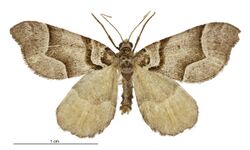Biology:Helastia siris
| Helastia siris | |
|---|---|

| |
| Male | |
| Scientific classification | |
| Domain: | Eukaryota |
| Kingdom: | Animalia |
| Phylum: | Arthropoda |
| Class: | Insecta |
| Order: | Lepidoptera |
| Family: | Geometridae |
| Genus: | Helastia |
| Species: | H. siris
|
| Binomial name | |
| Helastia siris (Hawthorne, 1897)[1]
| |
| Synonyms[2] | |
| |
Helastia siris is a moth of the family Geometridae. This species is endemic to New Zealand. It is classified as "At Risk, Relict'" by the Department of Conservation.
Taxonomy
This species was first described by E. F. Hawthorne in 1897 using a specimen he collected in Wellington and named Asaphodes siris.[3][2] George Hudson discussed and illustrated this species in his 1898 book under the same name and in his 1928 book as a synonym of Hydriomena triphragma.[4][5] In 1987 Robin C. Craw placed this species within the genus Helastia.[6] The holotype specimen is held at the Museum of New Zealand Te Papa Tongarewa.[2]
Description
Hudson described the species as follows:
The expansion of the wings is about 7⁄8 inch. The fore-wings are dull ochreous ; there is a small curved brown patch near the base ; then a pale band, followed by a very broad brown central band, paler in the middle ; there is a very sharp projection on the outer edge of the central band, a conspicuous black dot in the centre of the wing, and a series of minute black dots on the termen. The hind-wings are pale ochreous, with a faint central transverse line.[4]
Distribution
This species is endemic to New Zealand.[7][1] It occurs in Wellington, Stephens Island and in the Chatham Islands.[6] It has been collected from Baring Head.[8]
Biology and lifecycle
Very little is known about the biology of H. siris.[9] It is on the wing in March.[4]
Host species and habitat
This species prefers short tussock grassland habitat in coastal areas.[6] The host species for the larvae of H. siris is unknown.[9] It has been hypothesised the larvae of H. siris feed on the flowers of Helichrysum species and then feed on mosses, lichens or shrubs growing nearby.[10]
Conservation status
This moth is classified under the New Zealand Threat Classification system as being "At Risk, Relict".[11]
References
- ↑ 1.0 1.1 "Helastia siris (Hawthorne, 1897)". Landcare Research New Zealand Ltd. http://www.nzor.org.nz/names/0ea961c7-ac5c-4454-9099-5478c80a0e82.
- ↑ 2.0 2.1 2.2 Dugdale, J. S. (1988). "Lepidoptera - annotated catalogue, and keys to family-group taxa". Fauna of New Zealand 14: 181. http://www.landcareresearch.co.nz/__data/assets/pdf_file/0003/49008/FNZ14Dugdale1988150.pdf. Retrieved 16 May 2018.
- ↑ Hawthorne, E. F. (1897). "Descriptions of two new species of Lepidoptera." (in en). Transactions and Proceedings of the New Zealand Institute 29: 282–283. https://biodiversitylibrary.org/page/9974578.
- ↑ 4.0 4.1 4.2 Hudson, G. V. (1898). New Zealand moths and butterflies (Macro-lepidoptera). London: West, Newman & Co.. pp. 55. OCLC 10581623. https://biodiversitylibrary.org/page/23760207.
- ↑ Hudson, G. V. (1928). The Butterflies and Moths of New Zealand. Wellington: Ferguson & Osborn Ltd.. pp. 98. OCLC 25449322. http://www.bugz.org.nz/WebForms/ResultDetails.aspx?CurrentDoc=C7E94865-492F-45DA-9777-CC8E1E8B1438&back=true&NewDoc=true&searchType=1&SearchString=G.V.+Hudson.
- ↑ 6.0 6.1 6.2 Craw, R. C. (1987). "Revision of the genus Helastia sensu stricto with description of a new genus (Lepidoptera: Geometridae: Larentiinae).". New Zealand Journal of Zoology 14 (2): 269–293. doi:10.1080/03014223.1987.10422997.
- ↑ , p. 459, Wikidata Q45922947
- ↑ Crisp, Philippa (2008). "Baring Head ecological values". http://www.gw.govt.nz/assets/Parks-and-Recreation/East-Harbour/Baring-Head-redevelopment-reference-material/Biodiversity-and-landscape/Baring-Head-Ecological-Values-Report.pdf.
- ↑ 9.0 9.1 Patrick, Brian; Dugdale, John S. (2000). Conservation status of the New Zealand lepidoptera. Wellington, N.Z.: Department of Conservation, New Zealand. pp. 24. ISBN 978-0478218671. OCLC 154670803. https://www.doc.govt.nz/documents/science-and-technical/Sfc136.pdf.
- ↑ Patrick, Brian (2014). "Of lichens and mosses". Butterflies and Moths of New Zealand 11: 8. https://www.monarch.org.nz/wp-content/uploads/2014/11/MBNZT_Issue-11_Summer-2014_online.pdf.
- ↑ Hoare, R.J.B.; Dugdale, J.S.; Edwards, E.D.; Gibbs, G.W.; Patrick, B.H.; Hitchmough, R.A.; Rolfe, J.R. (2017). Conservation status of New Zealand butterflies and moths (Lepidoptera), 2015. Wellington, New Zealand: New Zealand Department of Conservation. p. 8. ISBN 9781988514383. http://www.doc.govt.nz/Documents/science-and-technical/nztcs20entire.pdf.
External links
Wikidata ☰ Q13879067 entry
 |


